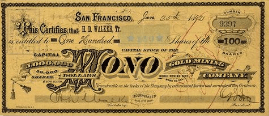Sunday, July 12, 1959 | by Bud Sprunger | Lewiston Morning
BODIE, Calif. (AP) – Only the specters of long-departed gunman, miners and ladies of the evening are around to celebrate the centennial of Bodie, a town that once produced 100 million dollars in gold and silver.
High in a cool, windy, desert valley near the Nevada Line, Bodie had a rowdy population of 10,000 at its peak around 1880. Now on its 100th birthday it is probably the ghostliest of the old West’s forgotten towns.
The writer and four other persons made a special trip to Bodie to drink an anniversary toast to the onetime roaring mining camp.
By listening to our imaginations, we could almost hear the bark of tarnished damsels and the clatter of glasses filled with product of Bodie’s five breweries.
But we had to listen hard. There’s not much left.
Gone is all of what was sarcastically called Virgin Alley, home of a covey led by Big Bonanza, who is famed for her generosity to broke miners and her ability as a practical nurse.
Photo caption: From Bodie to Garfield – E. W. Billeb, a New Yorker who fled Wall Street in 1907 to try his luck in a Nevada silver rush, stands beside a memorial marker at Bodie Calif., a onetime boom town that now is a ghost with but one resident – a watchman. Billeb was superintendent of a now extinct railroad which brought lumber to the rip-roaring, wide-open gold and silver mining town. The marker was bought to commemorate William S. Bodey, a placer miner who founded Bodie (folks just misspelled the name) But this was at the time when President James Garfield was killed, so the marker was reworded to serve as a memorial to the President. (AP Newsfeatures Photo.)
Only The Outlines
You can see only the outlines of the Bodie baseball diamond and the race track where harness horses imported from Europe raced during the city’s annual six-day July 4 celebration. Earl Bell, born here 63 years ago, and still a summer visitor, recalls that celebrating Independence Day actually took about a month.
George Hearst, father of the publisher, had big holdings here. Theodore Hoover, brother of the ex-President, was an engineer here and the houses where the Hoovers visited still stands.
If Bodie was not the most wide open town in the West, it wasn’t because it didn’t try.
An editor at Mariposa in the mother lode once quoted a little girl’s prayer as “Goodbye God. I’m going to Bodie” The Bodie editor replied that the Mariposa man’s grammar was faulty. What the girl meant was “Good, by God. I’m going to Bodie.”
Grammar and spelling were not exact sciences in this area. Bodie, for example, was named for William S. Bodey, a placer miner from Poughkeepsie, N.Y., who struck it rich here in 1859 and froze to death in a blizzard the next winter.
Mark Twain, who practiced newspapering 16 miles east in Aurora, once wrote he had no use for a man that knew only one way to spell a word.
E. W. Billeb, one of the heirs of J. S. Cain, who owns Aurora and most of Bodie, wants to sell the California town to the state as a park. The legislature has appropriated $200,000 and is talking about adding $150,000, but so far the Park Commission has dragged its feet.
The Cain estate maintains a watchman at Bodie in hopes of holding off the 20,000 souvenir hunting tourists who swarm in each summer. He is the total permanent population now of Bodie.
Bodie is down to 75 buildings, at least partly because it supported what was probably one of the most inefficient fire departments in history. The town suffered huge fires in 1882, 1932, and 1946, the last one ruining the final attempt to mine there. The only building left on one block is the fire station.
Engineers calculate there is still 150 million dollars worth of gold at Bodie, but it can’t be mined to profitably for $35 an ounce the US government pays.
More history: The Assassination of President James A. Garfield | History.com
